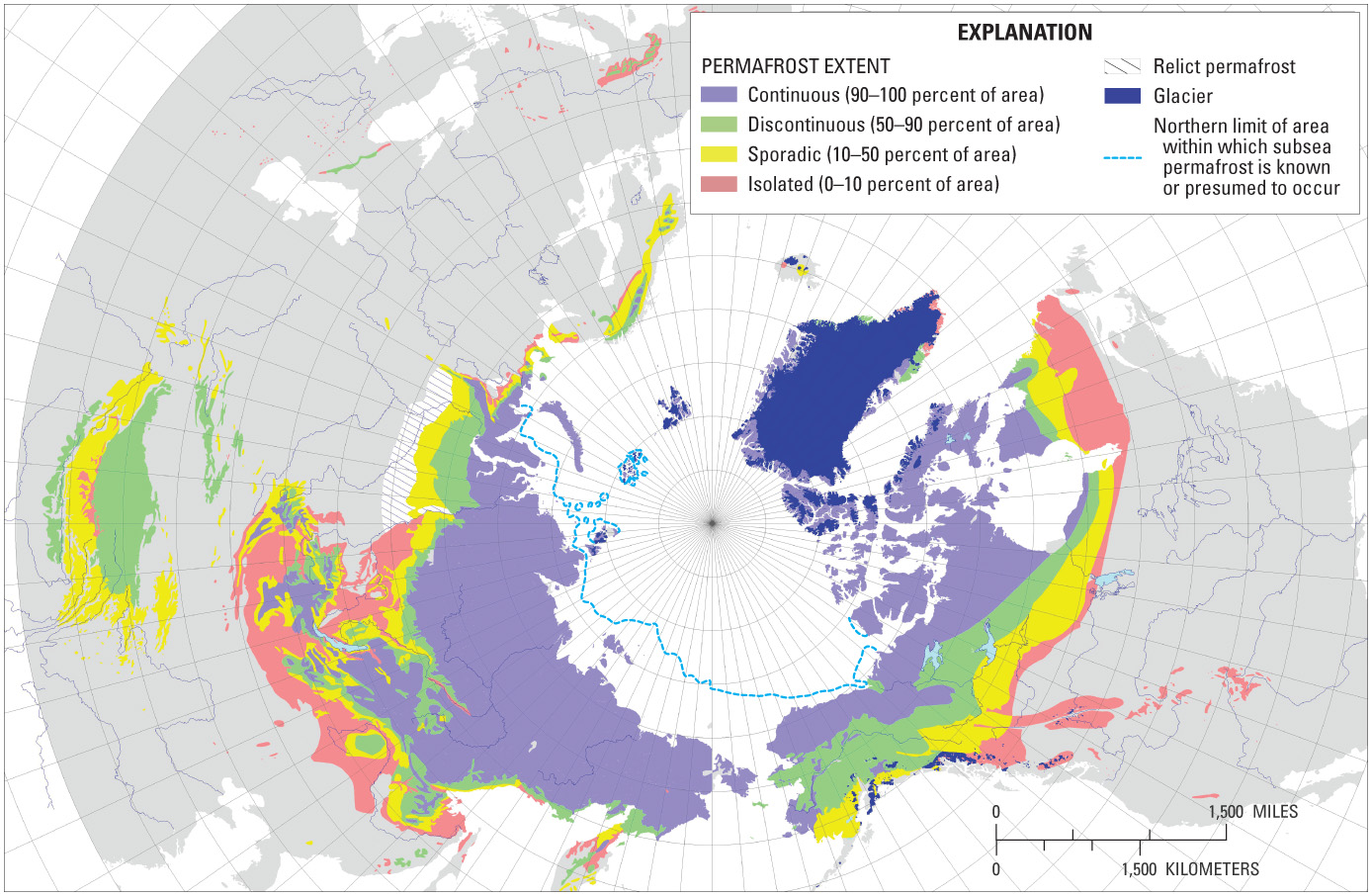Much of the high latitudes is covered in permafrost - soil or rock that remains at or below 0°C for at least 2 consecutive years (International Permafrost Association). In the Northern Hemisphere, regions in which permafrost occurs, cover 25% of the land area (23 million square km), though much of this is sporadic coverage (See Fig. 1). The thickness and depth of the permafrost also varies hugely with space, as layers can be anything from 10cm to 1500m thick.

Fig. 1. Extent of Northern Hemisphere permafrost. Source: USGS
Why is this important?
Permafrost is a major component in global carbon cycling, as it contains more than 1/3 of global organic carbon in soils (Wickland et al. 2005). As global temperatures increase, (and the poles warm at a much faster rate) huge swathes of permafrost degrade, thereby releasing the vast stores of carbon that they contain by way of carbon dioxide, methane and organic matter. This occurs because as the carbon rich frozen soils warm up, the organic matter they contain (such as peat which has accumulated over many thousands of years) becomes subject to bacterial decomposition. These bacteria feed on the organic peat soils as they thaw, as they have been prevented from doing so while the soil was frozen (perhaps for many thousands of years). In the process of decomposition, the bacteria release CO2 as they respire, in addition the the breakdown of the matter that is being decomposed. This is coupled with the fact that methanogenesis (producing methane) will have occurred while the soil was under anoxic (reducing) conditions. This CH4 is then emitted once the permafrost melts along with the CO2. Both CO2 and CH4 are potent greenhouse gases, thereby attributing to further warming, and hence further permafrost degradation. Evidently, this is yet another example of a positive climatic feedback. Wickland et al. 2005 estimate that the formation of thermokarst wetlands as a result of warming (as opposed to continuous permafrost) results in 13 fold increase in the volume of methane produced (and emitted to the atmosphere) over a given area.
An important point to note is that not all permafrost is on land. The East-Siberian Arctic Shelf (ESAS) covers more than 2 million square km of seafloor in the Arctic ocean, making it 3 times the size of the Siberian wetlands, which were previously thought to be the primary source of Northern Hemisphere atmospheric methane (National Science Foundation) (See Fig 2). The permafrost is a relic of previous glaciations, when sea level was lower and the peat producing landscapes of Siberia extended many hundreds of kilometres into what is now called the Laptev sea. The prolonged cold of the glaciations led to incredibly deep formation of permafrost, often over 1000m deep.However, after the onset of the Holocene, the permafrost has gradually been melting due to the increased temperatures (and higher sea levels).

Fig. 2. Source: Climate Progress
Shakhova et al. 2007, 2010, 2014 estimate that the ESAS is already releasing upwards of 1.1 teragrams of methane yearly, which is the same quantity as the rest of the ocean. This figure is only set to rise as the permafrost destabilises. Plumes of methane gas more than 1km wide have already been located. As the surface layer of the frozen ground thaws, it no longer forms a protective barrier which prevents escape of the gas. As methane is 30 times more potent as a greenhouse gas than carbon dioxide, this is particular example is potentially of huge global significance, because if the ESAS continue to melt at the current rate, then a large scale release of methane is all but inevitable.
A further point is that much of the methane stored in the ESAS is not in a gaseous state, but solid - methane clathrate. This substance in inherently unstable and is prone to becoming a gas very readily, especially as it is warmed up. This means that large build ups of highly pressurised methane gas form beneath the hard surface layer of the permafrost of the sea floor. As this hard, containing crust itself melts, the chance of a large scale 'blow out' increases dramatically as the pressurised gas seeks to rise upwards due to its low density. Shakhova says: “Our concern is that the sub-sea permafrost has been showing signs of destabilization already,” she said. “If it further destabilizes, the methane emissions may not be teragrams, it would be significantly larger” (National Science Foundation). This could potentially lead to a scenario such as that proposed by the Clathrate Gun Hypothesis, though this is now thought to be unlikely. Despite this, the basic principle of the methane emissions reinforcing the positive feedback loop remains.
So, melting permafrost is evidently a significant problem and one that I think should be monitored much more closely and given more public attention - it's remarkable how little literature there is regarding the topic in comparison to other similarly important topics such as sea-ice extent or impacts on wildlife. Whilst the problems discussed are unquestionably important, they are not extensive - next time I'll talk about some of the other impacts of melting permafrost such as its effects on infrastructure.
No comments:
Post a Comment